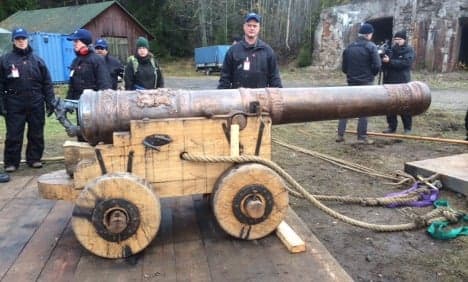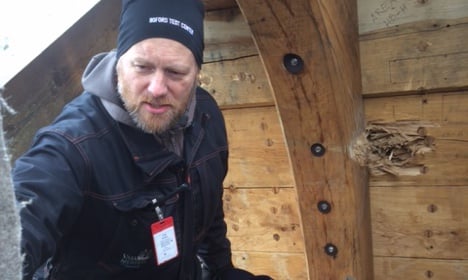Vasa ship cannon blasted in Sweden

A replica of one of the cannons present on Stockholm's iconic Vasa warship when it sank in 1628 is being tested for the first time in central Sweden.
Around two hundred people, including journalists, members of the Swedish military and friends of the Vasa Museum in Stockholm were invited to watch the debut cannon balls being propelled out of the bronze construction at the Bofors Test Centre in Karlskoga on Wednesday morning.
Shivering from both the cold and the excitement of the event, Vasa enthusiast Beth Dacey told The Local:
"There is such a great atmosphere here. Staff have dressed up in period outfits and made a real effort. I've spoken to people behind the project and some of them said they couldn't sleep last night. But I think they will be pleased with how it has gone."
The cannon was painstakingly recreated in order to find out more about the type of naval warfare tactics employed during the 17th century.
Sweden's Vasa warship is one of the country's most beloved vessels. It famously sank just 1,300 metres into its maiden voyage when it left the docks in the Stockholm harbour.
It remained under water until 1961 when it was brought to the surface and restored.
Sweden was the world's largest exporters of cannons during the 17th century and reproducing the mammoth weapon was a considerable challenge for those involved.
"It's a challenge to do something that they did back in 1628. We had never cast bronze at all here. It was a much bigger form than we usually use," Tomas Karlsson from the Tierps ironworks where the cannon was cast told SVT last December.

Fred Hocker from the Vasa Museum. Photo: Beth Dacey
Speaking just after the first blast, Fred Hocker from the Vasa Museum told The Local:
"Well it's a result, we made a hole! Now we've got to make some more."
He said that is team planned to look closely at the damage caused by the cannon balls, which were fired at a wooden construction based on the hull of the Vasa warship.
By looking closely at the dent in the wood, the team hopes to learn more about how effective the cannons would have been in historic battles.
"The ball created a smaller cloud of splinters than I would have expected," added Hocker.
More different types of cannon balls were scheduled to be tested on Wednesday afternoon.
Comments
See Also
Around two hundred people, including journalists, members of the Swedish military and friends of the Vasa Museum in Stockholm were invited to watch the debut cannon balls being propelled out of the bronze construction at the Bofors Test Centre in Karlskoga on Wednesday morning.
Shivering from both the cold and the excitement of the event, Vasa enthusiast Beth Dacey told The Local:
"There is such a great atmosphere here. Staff have dressed up in period outfits and made a real effort. I've spoken to people behind the project and some of them said they couldn't sleep last night. But I think they will be pleased with how it has gone."
The cannon was painstakingly recreated in order to find out more about the type of naval warfare tactics employed during the 17th century.
Sweden's Vasa warship is one of the country's most beloved vessels. It famously sank just 1,300 metres into its maiden voyage when it left the docks in the Stockholm harbour.
It remained under water until 1961 when it was brought to the surface and restored.
Sweden was the world's largest exporters of cannons during the 17th century and reproducing the mammoth weapon was a considerable challenge for those involved.
"It's a challenge to do something that they did back in 1628. We had never cast bronze at all here. It was a much bigger form than we usually use," Tomas Karlsson from the Tierps ironworks where the cannon was cast told SVT last December.

Fred Hocker from the Vasa Museum. Photo: Beth Dacey
Speaking just after the first blast, Fred Hocker from the Vasa Museum told The Local:
"Well it's a result, we made a hole! Now we've got to make some more."
He said that is team planned to look closely at the damage caused by the cannon balls, which were fired at a wooden construction based on the hull of the Vasa warship.
By looking closely at the dent in the wood, the team hopes to learn more about how effective the cannons would have been in historic battles.
"The ball created a smaller cloud of splinters than I would have expected," added Hocker.
More different types of cannon balls were scheduled to be tested on Wednesday afternoon.
Join the conversation in our comments section below. Share your own views and experience and if you have a question or suggestion for our journalists then email us at [email protected].
Please keep comments civil, constructive and on topic – and make sure to read our terms of use before getting involved.
Please log in here to leave a comment.